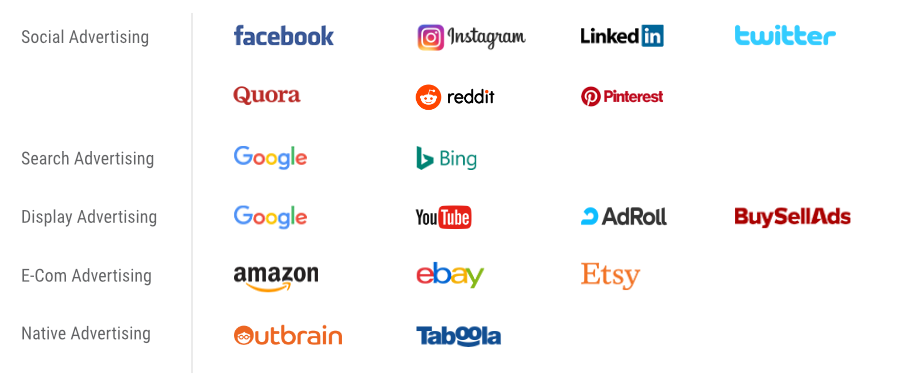
Does your advertising drive growth?
Digital Advertising that Gets Results
We help growth-stage online businesses target the right message to the right audience at the right time. We do this is by using modern, data-driven, digital advertising techniques. We’ll help you create results-driven campaigns that win and can transform your business.
Common Issues
Top reasons most companies aren’t getting the most from their digital advertising strategy.
- No workable process for A/B testing, evaluating ads, iterating on design, or measuring performance.
- Ad budgets that are too small to generate results on new and yet to be optimized campaigns.
- Ad budgets that are too big that waste funds before campaigns have been proven to succeed.
- Investing in video, rich media, or HTML 5 ads before obtaining from simple image ads.
- Not having a properly set-up, verified, or optimized advertising analytics solution.
- Too many cooks in the kitchen. Lack of a single decision maker leading to muddled strategy, objectives, or design.
- Ego driven ads created to satisfy internal team members not the target audience.
- Poor campaign conceptualization, unprofessional design, or sloppy roll-out.
- Decision-making without the use of statistically significant and verified data.
- Making too many rapid changes to a campaign or not giving it enough time to deliver learning and results.
- Poor website or landing-page design, uncompelling product/service/offer, poor price model, or lack of project differentiation.
Profitable Advertising
What could you do if your advertising was profitable?
Imagine how different your business would look if your revenue growth was on-demand.
What you would do with a positive return on your advertising investment? Would you spend more to acquire more customers, improve your product/service offering, hire more staff?
It all starts with profitability.
Now imagine what you could do if your advertising was profitable and consistent.
We’ll help you create a portfolio of on-going advertising campaigns that are profitable and scalable so you can harness your business’s potential.
Our strategy covers the complete advertising funnel for systematic, ongoing optimization at key points that can effect big change. We’ll start with your goals and constraints in order to work backwards into an actionable advertising budget. Then we’ll test, optimize, and evaluate performance in cultivating high-impact, winning campaigns.
How We Do It
Using a 3-stage approach, we’ll turn concepts into campaigns, and campaigns into winners.
Stage 1: Proof of Concept – We start by testing high-probability concepts in a live environment to determine whether it has the potential for further optimization. If the campaign passes our proof-of-concept test, it moves on to the optimization stage. Campaigns that do not pass this test are cut or put on hold. We structure campaigns to deliver knowledge and learnings value, whether they pass or fail the proof-of-concept test.
Stage 2: Optimize into Winners – Here we perform the most important and systematic optimization functions. These include A/B testing, targeting adjustments, conversion-rate optimization, design iteration, and statistical analysis. This is where we turn potential opportunities into real winners.
Stage 3: Portfolio Scaling and Growth – When a campaign has demonstrated consistent performance, it becomes part of the ongoing portfolio. Here we continue to test, evaluate, and iterate, but the focus shifts to scaling and growth. Campaigns in this stage give business owners the most control over visitor traffic, lead generation, and sales growth.
Advertising Networks
We specialize in a variety of digital advertising mediums, platforms, networks, and more.

…and plenty of others!
We’re Data Driven
When we say data-driven, we mean DATA-DRIVEN!
Gain new confidence with your digital advertising campaigns. We employ a digital advertising strategy aimed at delivering results that progressively improve over time. To do this, it’s important that we measure accurately, interpret properly, and recommend smartly.
Here are just a few advanced tactics we employ:
Statistical Significance – We use a few different statistical tests for significance to determine whether results are caused by something other than random chance.
SCB Ratio Correlation (Scale, Cost, Benefit) – When scaling up campaigns, it’s important to determine if there is an upper limit to the ad spend where the benefits are no longer cost-effective with each additional dollar added.
Machine Learning – When possible, we employ third-party, machine-learning algorithms to help auto-optimize target audience indexing (filtering and ordering of an audience by potential), performance-based ad selection, and campaign cost per acquisition.
Trend Analysis – Discovery of trends using campaign data allows us to gain insight into audience behavior, seasonality effects, competitive changes, campaign lifespans, audience burnout, and more. This type of analysis helps us to better understand changes in the marketing environment and how to best adapt smartly.
Predictive Forecasting – We use predictive forecasting to help determine what future performance might look like. While not 100% accurate, this tactic can give us potential ranges or insight into future outcomes that aid in decision-making and confidence-building.
Solve for X – In crafting advertising strategies, we tend to work backwards from the desired results and target metrics we would like to achieve. In doing so, we then solve equations for input variables and answer questions like, “What should be my starting advertising budget?” or “How many clicks do I need to get a statistically significant amount of sales?”
Don’t worry, we love this stuff so you don’t have to!
Audience Targeting Tactics
If your audience is online, we’ll find them with these audience targeting tactics.
Interest Targeting – Matches to target audience likes, affinities, desires, and interests.
Contextual Targeting– Matches to relevant content topics, keywords, and text.
Retargeting – Locates audience members after they’ve engaged with your website, page, ad campaign, content, or social media.
Look-alike Targeting – Builds a model of the ideal audience member from actual data and then finds individuals who match.
Search Intent – Matches to those who have announced what they’re looking for or have asked a question.
Demographic Filtering – Refines audiences by age, gender, location, income, job title, psycho-graphic, or behavioral data.
Data Matching – Matches lists of names or email addresses to their online presences.

